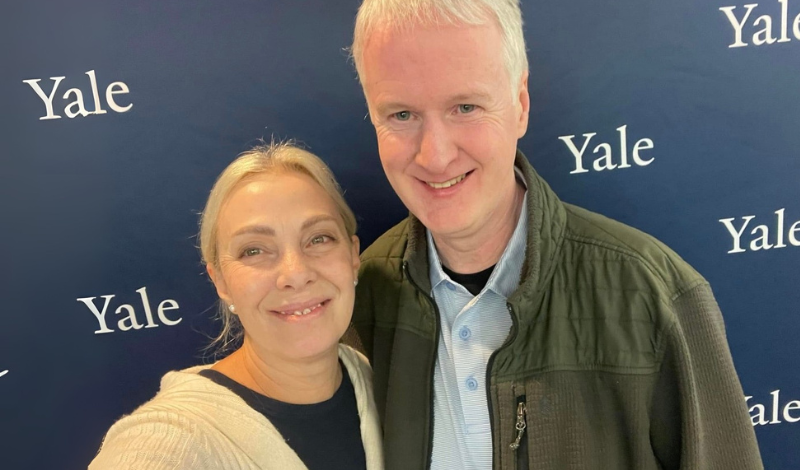
When Family Loss Leads to Life-Saving Action
Small cell lung cancer early detection can mean the difference between life and death – a truth that becomes powerfully clear in Joi Kiley’s remarkable journey. In most cases, a Small Cell Lung Cancer diagnosis is dire. A fast-growing and aggressive form of lung cancer, it is often not detected early enough to treat successfully. Unlike Non-Small Cell Lung Cancer, a diagnosis is not staged; rather, it is deemed either limited (cancer is confined to the chest) or extensive (cancer has spread beyond the chest). Early detection, however, is the key to successful treatment and cure.
In the fall of 2021, then 53-year-old Joi Kiley lost her brother to lung disease, pulmonary fibrosis, and lymphoma. Shaken by his passing, Joi scheduled an appointment with her primary care physician and asked if there was any testing that could be done to see if she, too, might have lung disease. Due to the family history and the fact that Joi was a smoker, she was eligible for a low-dose CT scan to assess her lungs. Results yielded evidence of a fatty nodule with instructions to return for a follow-up scan in three months.
The Silent Struggle: Facing Cancer Fears Alone
The next three months were challenging for Joi. She felt such shame that she had brought this on herself that she did not share the information with anyone, including her husband, children, or family. She couldn’t bear the thought of her mother losing another child. She was riddled with guilt. It wasn’t until her follow-up scan, when the nodule had grown significantly, that she shared the information with her husband. This was just one hour before a Zoom call with the pulmonologist.
Following that call, Joi underwent extensive bloodwork and a bronchoscopy. Days later, she got the call:
“You have small cell carcinoma”.
Small Cell Lung Cancer Treatment: A Race Against Time
From there, things moved quickly. Joi met with her oncologist, had a port placed for her chemotherapy treatment, and began treatment: four cycles of chemotherapy every three weeks, along with 15 days of twice-daily radiation.
“The oncologist told me that he believed that this tumor had not been there more than 6 to 8 weeks and, thanks to the low-dose CT scan, it was caught. I was lucky that it was limited. He encouraged me, reminding me that I was young and otherwise healthy, so, although a grueling protocol, it would be worth it as the goal was “curative intent” as opposed to postponing the inevitable.”
Complete Response: The Power of Early Detection
On June 20, 2022, Joi underwent her final chemotherapy treatment. On July 21, Joi learned that she had a “complete response”. In other words, the cancer was gone, and she was declared to be NED (no evidence of disease).
Out of an abundance of caution and to be certain that there had been no metastases, Joi’s medical team recommended she have a prophylactic cranial scan. Following that test, she underwent 10 rounds of brain radiation. A clear brain scan yielded an all clear result. Joi has now been NED for three years. She continues to have scheduled CT scans of the chest and brain.
Breaking Through Shame: The Emotional Journey of Lung Cancer
Important to note in Joi’s story is the guilt and shame that she struggled with. Having been a smoker, she blamed herself for having gotten small-cell lung cancer. Unlike non-small lung cancer, which anyone with lungs can get, small cell lung cancer is more closely associated with smoking. As a result of this emotional distress, Joi flew solo for much of her journey. As previously noted, she kept her test results to herself for three months before sharing the information with her husband.
She waited even longer, when her hair started to fall out, to be precise, to tell her adult children and her mother. She wanted there to be a plan in place before telling them. Joi went to every chemotherapy and radiation appointment by herself, solely because of the shame she felt having “done this to herself”. As a result, she grew increasingly anxious and concerned. It wasn’t until she found an online community that she was able to rise and feel strong and empowered. This led to a commitment to advocating for herself and other lung cancer patients.
From Patient to Advocate: Spreading the Life-Saving Message
The first act of advocacy she embraced was ensuring that her identical twin sister was able to have the same low-dose CT scan that had saved Joi’s life. Originally denied by insurance, Joi worked tirelessly to get her sister tested. Her results: no cancer.
Joi’s response to treatment for a small-cell lung cancer diagnosis would have been unheard of just a few years ago. Without question, the low-dose CT scan saved Joi’s life. All thanks to research that continues to prove small cell lung cancer early detection transforms what was once a hopeless diagnosis into a story of complete recovery and renewed purpose.
I’m using my lungs to advocate
As a member of LCFA’s Speakers Bureau, I’m advocating for research and raising awareness through the media, embodying hope and action.
View Speaker Profile
